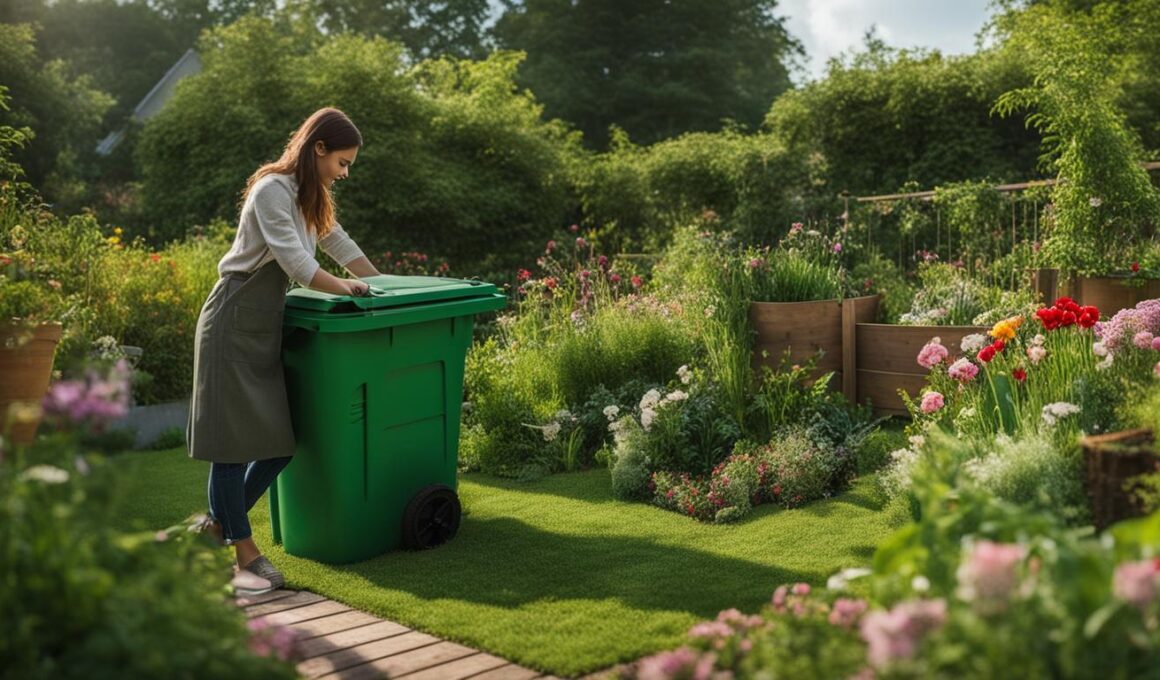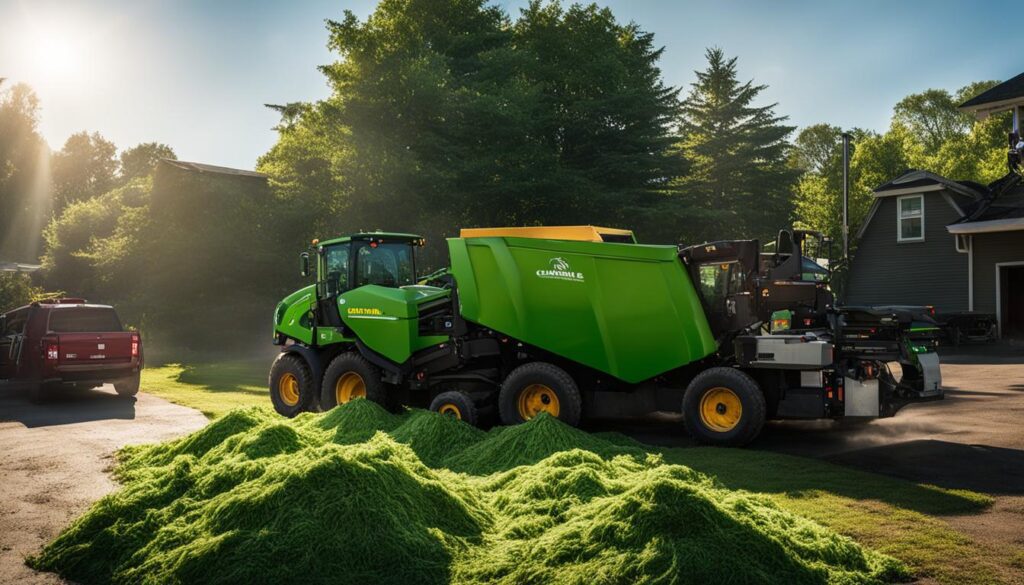Are you looking for eco-friendly ways to dispose of grass clippings after mowing your lawn? With more U.S. states banning yard debris, including grass clippings, from landfills, it’s essential to find alternative methods to manage lawn care waste. This article will explore some environmentally friendly options such as on-site mulching, composting, and curbside composting programs, which offer significant benefits for your lawn and the environment.
Key Takeaways
- Many states prohibit grass clippings and yard debris from landfills, making eco-friendly disposal methods increasingly important.
- Mulching your grass clippings on-site is an excellent environmentally friendly option, reducing the need for transportation and landfill space, while providing nutrients to your lawn.
- Composting grass clippings is another beneficial strategy, both for your lawn’s health and for reducing methane emissions associated with grass decay in landfills.
- Curbside composting programs can be a convenient and sustainable alternative to transporting yard waste to a landfill.
- It’s essential to check local guidelines and resources for disposing of your grass clippings, to comply with environmental safety standards and benefit your lawn’s health.
Evaluating Your Lawn Care Routine: Understanding Grass Clipping Disposal
With increasing concerns about environmental impacts and stricter state regulations pertaining to yard waste in landfills, it is essential to reevaluate your lawn care routine to ensure it includes proper grass clipping disposal methods. Not only is it important for legal compliance, but incorporating eco-friendly lawn maintenance practices also benefits both the environment and the health of your lawn.
One of the ways to manage grass clippings is through curbside composting programs. These programs offer a convenient and environmentally safe solution for disposing of your grass clippings. Before signing up, ensure that your local waste disposal facility practices safe and eco-friendly methods while handling yard waste.
Alternatively, you can consider utilizing yard waste centers for your grass clipping disposal needs. These centers usually offer recycling or composting services, which can help reduce the environmental impacts of yard waste disposal in landfills. However, it is crucial to verify that the center adheres to environmental safety practices before using their services.
Beyond legal compliance and environmental benefits, proper grass clipping disposal can positively impact the overall health of your lawn. By choosing eco-friendly lawn maintenance methods, you not only support a greener environment but also contribute to the sustainability and longevity of your green spaces.
| Eco-friendly Grass Clipping Disposal Methods | Environmental Benefit | Lawn Health Benefit |
|---|---|---|
| Mulching grass clippings | Reduces methane emissions from landfills | Improves soil nutrition and health |
| Composting | Conserves landfill space and reduces greenhouse gases | Provides a nutrient-rich soil amendment |
| Curbside composting programs | Decreases landfill waste and associated emissions | Promotes responsible waste management in the community |
| Yard waste centers | Encourages recycling and proper disposal of green waste | Helps maintain the overall health of the lawn |
In conclusion, taking the time to evaluate your lawn care routine and incorporating proper grass clipping disposal methods can significantly benefit your lawn’s health and contribute positively to the environment. It is crucial to be aware of and utilize the eco-friendly lawn maintenance options available in your area to effectively manage your grass clippings and support a greener future.
Eco-Friendly Alternatives to Traditional Disposal
With the increase in landfill restrictions and the push for sustainable waste management practices, it is crucial for homeowners to explore eco-friendly alternatives for disposing grass clippings. Some of the most prominent methods include mulching, composting, and curbside composting programs, all of which offer various benefits for lawn health, the environment, and waste management.
The Benefits of Mulching Your Clippings
Mulching offers multiple mulching benefits as it not only repurposes grass clippings but contributes to lawn health by organic matter recycling and improving soil composition. By mulching grass clippings directly into the lawn, you can eliminate the need for transportation, limiting methane emissions produced by clippings decomposing in landfills. Mulching also adds organic matter and nutrients to the soil, reducing the need for chemical fertilizers and watering, and minimizing the risk of thatch buildup and increased waste production.
Composting: Turning Your Grass Clippings into Garden Gold
Composting is another excellent way to take advantage of the benefits of grass clippings reuse while contributing to soil improvement. By adding grass clippings to a compost pile or bin, you can recycle the clippings into nutrient-rich compost, which can then be used in gardens and landscapes. This method requires mixing grass clippings with other forms of organic matter such as straw or leaves, promoting more efficient decomposition while preventing unpleasant odors caused by anaerobic conditions.
- Collect grass clippings and mix with dry organic materials such as leaves or straw.
- Monitor moisture levels in the compost pile, ensuring it is neither too wet nor too dry.
- Turn the pile regularly to promote oxygen flow and speed up decomposition.
- Monitor the temperature; a hot pile indicates high levels of decomposition.
- Utilize the resulting compost to improve soil nutrients and structure.
Adopting a balanced composting approach not only increases efficiency but also reduces adverse effects on soil and air quality stemming from improper decomposition.
The Role of Curbside Composting Programs
Curbside composting programs are an efficient alternative to traditional disposal methods and play a significant role in environmental benefits such as greenhouse gas reduction, soil improvement, and waste management. These programs, offered by many municipalities, involve recycling grass clippings into nutrient-rich compost rather than sending them to landfills. By eliminating the need for decomposition in landfills, these programs reduce the production of methane emissions and preserve limited landfill space.
| Eco-friendly Disposal Method | Environmental Benefits | Lawn and Garden Benefits |
|---|---|---|
| Mulching | Reduces methane emissions, conserves water | Improves soil nutrition and structure, reduces need for fertilizers and watering |
| Composting | Reduces methane emissions, conserves landfill space | Produces nutrient-rich compost, improves soil quality |
| Curbside Composting Programs | Reduces greenhouse gas emissions, supports waste management | Recycles grass clippings into compost, reduces dependency on chemical fertilizers |
Furthermore, curbside composting programs support the production of compost for agricultural purposes, reducing dependency on chemical fertilizers and thus limiting water pollution caused by fertilizer runoff.
By implementing these eco-friendly disposal methods, you can contribute to a greener and more sustainable environment while simultaneously enhancing the health and longevity of your lawn.
Local Yard Waste Programs: Where to Take Your Grass Clippings
As mentioned earlier, many municipalities offer yard waste programs where residents can bring their grass clippings for composting or recycling, often at no cost. These programs support environmentally friendly disposal and ensure that clippings are processed in ways that do not harm the ecosystem. Checking the local guidelines for yard waste disposal is essential to ensure compliance and environmental safety.
A excellent first step in locating your local yard waste programs is to visit your city or county’s website for detailed information on disposal locations and guidelines. Alternatively, call your municipal waste management department for information on recycling and composting services.
When you bring your grass clippings to a local yard waste program, expect the following procedures:
- Transporting your grass clippings in a reusable container, paper lawn and leaf bags, or other biodegradable materials.
- Depending on the location, you may have to dump the grass clippings in a designated area or pile.
- Sorting and/or bagging your grass clippings may be required by the facility.
Make sure to check and comply with all guidelines related to acceptable materials, hours of operation, and seasonal schedules for your local yard waste program.
For those seeking a more sustainable option, consider some of the more significant yard waste programs, such as composting services provided by Waste Management and Republic Services. These companies offer residential and commercial composting programs in many areas across the United States.
Grass clippings recycling
and composting services are vital in preserving our environment by diverting waste from landfills. By participating in your local yard waste programs, you are contributing to a sustainable waste management solution while giving your lawn the best possible nutrients for growth and overall health.
Managing Thatch Buildup: Dispelling Myths Around Grass Clippings
Thatch is a prevalent issue in lawn care, often causing confusion and leading to misconceptions about the role of grass clippings in its formation. By understanding the true causes of thatch and the effects of grass clippings on soil health, you can make informed decisions about your lawn maintenance practices and promote long-term lawn health.
What Causes Thatch in Your Lawn?
Thatch is primarily composed of grass roots, stems, and other organic matter that are slow to decompose. Some of the main causes of thatch buildup include excessive nitrogen fertilization and infrequent mowing. The following table summarizes the primary factors contributing to thatch development in lawns:
| Thatch Cause | Explanation |
|---|---|
| Excessive Nitrogen Fertilization | Over-fertilizing your lawn with nitrogen-based products can lead to rapid growth and dense root systems, making it difficult for microbes to break down the organic matter, thus causing thatch buildup. |
| Infrequent Mowing | Waiting too long between mowing sessions can result in taller, thicker grass clippings that take longer to decompose, potentially contributing to thatch. |
| Overwatering | Excess water can lead to shallow root systems and impede the organic matter decomposition process needed to break down thatch naturally. |
Proper lawn care and maintenance can help minimize thatch development and improve the overall health of your lawn.
How Grass Clippings Affect Your Soil’s Health
Contrary to common myths, grass clippings decompose rapidly and do not significantly contribute to thatch buildup. Due to their high water content and nitrogen levels, decomposing grass clippings help return vital nutrients to the soil. This promotes microbial activity and reduces the need for additional fertilizers.
By adhering to proper mowing schedules and mulching clippings, you can prevent clipping matting and enable them to act as a natural fertilizer. Here are some benefits of grass clippings decomposition:
- Enhances soil health by increasing organic matter and nutrients.
- Improves soil structure and water retention capacity.
- Reduces the need for chemical fertilizers and the risk of pollution from fertilizer runoff.
- Promotes microbial activity and natural decomposition of organic matter.
Incorporating grass clippings as part of your lawn maintenance practices can significantly improve soil health and contribute to a lush, healthy lawn without exacerbating thatch issues.
Are Grass Clippings Safe to Use as Mulch in an Environmentally Friendly Manner?
Yes, grass clippings are safe and effective to use as mulch in an environmentally friendly manner. This sustainable lawn care practice helps retain moisture, suppress weeds, and add nutrients back to the soil. It also reduces the need for chemical fertilizers, making it a great option for eco-conscious gardeners.
Conclusion
Incorporating sustainable lawn management practices into your routine is essential for both the wellbeing of your lawn and the environment. By exploring and utilizing eco-friendly grass recycling tips, you can ensure compliance with local regulations while minimizing your environmental impact.
Some of the best methods for handling grass clippings include mulching, composting, and participating in curbside and local yard waste programs. These disposal techniques not only support a greener lawn but also offer significant environmental benefits such as reducing greenhouse gas emissions, conserving landfill space, and decreasing water pollution from fertilizer runoff.
Taking a proactive approach to environmental lawn care will not only enrich your lawn’s health but also contribute to the collective effort to protect our planet. By adopting responsible lawn care practices, you will be playing your part in safeguarding the environment for future generations.












